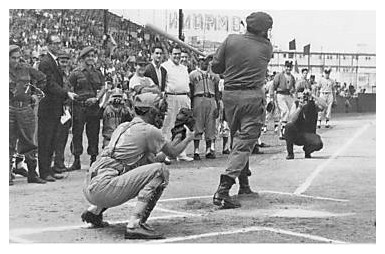July 25, 1959: Celebratory gunfire brings a frightful end to Sugar Kings game in Havana
Fidel Castro records the ceremonial first hit of Cuba’s baseball season on January 14, 1962 against Azucareros starter Jorge Santín at Gran Stadium in Havana. (Courtesy of Peter C. Bjarkman)
As the International League’s Rochester Red Wings prepared to play a doubleheader with the Montreal Royals on July 4, 1959, some of them might have noticed an article about Cuba on page one of that day’s Rochester Democrat and Chronicle.
Of particular relevance for manager Cot Deal and his players would have been Fidel Castro’s plan to have “a half-million peasants … with their machetes,” come to Havana on July 26, for the first public celebration of the event that sparked the Cuban Revolution.1 Six years earlier, Castro had led a group of students in a failed attack on the Moncada army barracks in Santiago, spawning the 26th of July Movement, which propelled Castro, in January 1959, to overthrow the regime of the Cuban dictator Fulgencio Batista.
Three weeks after commemorating Independence Day in the US, the Red Wings experienced a decidedly more terrifying brand of revolutionary revelry in the Cuban capital when their July 25 night game against the Havana Sugar Kings stretched past midnight.
A Cincinnati Reds affiliate owned by Bobby Maduro, a US-educated son of a wealthy Cuban insurance executive, the Sugar Kings were filled with talented young Cubans destined for major-league success, including Mike Cuellar, Cookie Rojas, Leo Cárdenas, and Tony González. Last-place finishers in the Triple-A International League the year before, the Sugar Kings were led by first-year manager Preston Gómez. A former Washington National, Gómez had played in 1952 for Maduro’s Havana Cubans entry in the Class B Florida International League.
The Sugar Kings were two games under .500 but only two games out of second place and a half-game behind Rochester when the Red Wings came to town on July 24 for a three-game series. Havana was the last stop on a season-long 21-game road trip for the longtime St. Louis Cardinals farm team.2 More than 200,000 out-of-town revelers had already arrived in Havana as the first of three games was held at Stadium El Cerro (identified as Gran Stadium in US English-language newspapers), many of them wearing palm-leaf hats and carrying machetes as requested in Castro’s clarion call.3
Before the Rochester-Havana tilt, spectators were treated to a benefit game that featured the man of the hour. Before “an enthusiastic crowd of over 30,000 fans,” Castro pitched two innings for a Cuban army pickup team against members of the military police.4 Many in the crowd may have wondered if baseball was to be Castro’s new calling – days earlier he had resigned his position as prime minister in a dramatic nationwide radio address. The Sugar Kings topped Rochester, 4-2, in the game that followed, for their ninth win at home in 10 games.5
A significantly smaller crowd was on hand at El Cerro the next night. A box score in The Sporting News listed 2,372, with an Associated Press game summary putting late-game attendance at “about 3,000,” numbers consistent with other Saturday Sugar Kings games.6 Many were guajiros (rural peasants) and armed barbudos (bearded Cuban soldiers).7
The evening’s entertainment began with Havana and Rochester playing the last few innings of a suspended game from June 7, a seven-inning scoreless tie when play was halted to allow the Red Wings to catch a plane.8 The Sugar Kings scored a run in the eighth off starter Bob Keegan and hung on for a 1-0 victory.9
Having thrown only one inning in the preliminary bout, Keegan, the Red Wings ace with a record of 11-6, was back on the hill for the main event. Opposite the Rochester native and former Chicago White Sox hurler was Havana native and former Chicago Cubs hurler Vicente Amor. In late April, Amor had authored a four-hit shutout of the Red Wings in Havana.10
The Sugar Kings broke the ice in the first inning, with catcher Jesse Gonder driving in leadoff batter Yo-Yo Davalillo with an unearned run after an error by third baseman Gene Green.11 Rochester scored twice in the second and once in the third, knocking Amor out of the game in favor of Pedro Carrillo. How the Red Wings scored was left unreported in newspapers’ game summaries, but Luke Easter, Billy Harrell, and recent addition Lee Tate were each credited with an RBI.12
Neither side was able to push another run across until the bottom of the ninth, when the Sugar Kings scored twice. Facing Rochester reliever Tom Hurd, the Sugar Kings’ Larry Novak reached on a two-out error by Tate at second base, bringing Havana’s top home-run hitter, 21-year-old Rogelio Álvarez, to the plate. Álvarez evened the score at 3-3 when he clubbed his 19th home run of the year over the center-field wall.13
In the top of the 11th, Harrell gave Rochester the lead with a solo home run over the right-field fence off southpaw Luis Arroyo. Leading off the bottom of the inning, Gonder doubled down the left-field line but Red Wings manager Deal was sure that he’d missed first base. First-base umpire Frank Guzzetta disagreed. Deal suggested Guzzetta “was afraid of those guns in the stands,” triggering his immediate ejection.14
When play resumed, Gómez replaced the slow-footed Gonder with Hank Izquierdo.15 He scored when the next batter, Novak, roped a single to left field. Cárdenas, a 20-year-old who had singled and scored Havana’s only run in the conclusion of the suspended game earlier, moved the winning run into scoring position with a one-out single but an inning-ending double play ended the chance at a walk-off.
Leading off the 12th inning, Arroyo retired Red Wings catcher Dick Rand on a grounder to short, bringing up Hurd.16
The clock struck midnight and all hell broke loose.
Fireworks went off outside the stadium to mark the start of the July 26 celebration, the Cuban national anthem began playing, and soldiers both inside and outside El Cerro began shooting into the air – “mostly … from tommy guns, burp guns and sub-machine guns[,]” according to George Beahon, sports editor of the Democrat and Chronicle.17 “It sounded like a war,” said Rochester player-coach Frank Verdi, thrust into the role of acting manager just minutes earlier.18
Standing in the third-base coaching box, Verdi was knocked down by a .45 caliber round that tore through his ballcap, bounced off a plastic hat liner underneath and hit his ear.19 “If that bullet had been two inches to the left, the boys on the ballclub would have had to chip in $5 apiece for flowers,” he later told reporters.20 Deal, whose place he’d taken, never wore a hat liner.21
Coming to Verdi’s aid, third-base umpire Ed Vargo felt a bullet whiz past his chest and another nearly hit a leg. At about that same time, a bullet struck Cárdenas above the right shoulder blade as he stood at his shortstop position. It ripped his uniform and, according to some reports, broke the skin.22 “I thought somebody hit me with a rock,” Cárdenas told ESPN decades later.23
The Red Wings walked off the field and umpire Guzzetta, the crew chief, declared the game suspended. An hour later, players and umpires were still shaken by the ordeal. Deal announced that Rochester would not take part in Sunday’s scheduled series finale, or complete the game suspended by gunfire.24 International League President Frank Shaughnessy agreed, saying, “I could not order them to play, if they thought they were in physical danger.”25
The Havana press ridiculed published accounts of the gunfire incident authored by Verdi and others affiliated with the Red Wings. “Que mentirosos y calumniosos son estos buenos senores del equipo del Rochester [How deceitful and slanderous these good gentlemen of the Rochester team are],” charged Noticias de Hoy. Only a few soldiers had fired their guns into the air, claimed the Havana daily, pointing to the fact that Verdi didn’t need hospital care as further evidence that Rochester personnel had exaggerated what happened.26 Maduro sang a similar tune, telling reporters that officials had exaggerated the incident in reports to Red Wings President Frank Horton. The Red Wings were “running out,” according to Maduro, “us[ing] any excuse” to avoid playing a makeup doubleheader.27
The midnight incident at El Cerro served as the opening act for a host of raucous but less life-threatening celebrations held later that day. Festivities kicked off with a parade through streets swollen with onlookers and concluded with as many as one million Cubans filling the Plaza de la Republica to hear from Castro, who earlier in the day had agreed to serve as prime minister once again.28
Dismissing concerns about pennant race impacts, Shaughnessy allowed Rochester to skip making up the two games in Havana but made clear that all other games remaining to be played in Havana would go on as scheduled.29
Saved from having to play all their games on the road, the Sugar Kings won 28 of their final 48 to finish the season in third place. With Castro in the stands at El Cerro for the deciding game, Havana captured the International League pennant, winning the Governors’ Cup, by toppling the Richmond Virginians. They went on to outlast the American Association Minneapolis Millers in winning the Junior World Series.30
Relations between Cuba and the US continued to deteriorate after the 1959 season and into the next. On June 29, 1960, Castro ordered the seizure of a Texaco oil refinery and threatened to take all “Yankee property [in Cuba] down to the nails in their shoes.”31 A week later, Shaughnessy moved Maduro’s Havana franchise to Jersey City, New Jersey, citing the need to “protect our players.”32 Drawing an average of only 815 spectators per game, the former Sugar Kings folded after the 1961 season.
Acknowledgments
This article, made possible by my wife Kelly’s translations of Spanish-language newspaper articles I used as sources, was fact-checked by Kurt Blumenau and copy-edited by Len Levin.
Sources
In addition to the Sources cited in the Notes, the author consulted Roberto González Echevarría’s The Pride of Havana: A History of Cuban Baseball (New York: Oxford University Press, 1999); John Harris and John J. Burbridge, Jr.’s “The Short but Exciting Life of the Havana Sugar Kings” in The National Pastime, 2016; game summaries published in the Havana Dario de la Marina, The Sporting News, Buffalo News, Richmond (Virginia) Times-Dispatch and Rochester Democrat and Chronicle. He also utilized information posted on the Baseball-Reference.com, Retrosheet.org, and statscrew.com websites.
Notes
1 “Castro Spurns Ike’s Proposal on Area Peace,” Rochester Democrat and Chronicle, July 4, 1959: 1. Two weeks earlier, Castro had announced plans for a July 26 “rally of a half million peasants … in support of the agrarian reform.” Fidel Castro, “’We Have Put an End to the Eviction of the Peasants, Made Them Owners of the Land,’” June 1959 speech, English translation, The Militant, May 31, 1999, https://www.themilitant.com/1999/6321/6321_10.html.
2 George Beahon, “Royals Rip Wings as Pitching Fails Again,” Rochester Democrat and Chronicle, July 12, 1959: 47. Previous stops on the trip included Montreal, Toronto, Buffalo, and Miami. Rochester first became a Cardinals farm team in 1928. The club formerly known as the Tribe changed its name to the Red Wings in recognition of that relationship. “Red Wings Will be New and Official Name of Rochester Club,” Rochester Democrat and Chronicle, February 28, 1928: 9.
3 “‘We Have Put an End to the Eviction of the Peasants, Made Them Owners of the Land’”; Adolfo Marti, “La Habana jubilosa por los actos del dia 26,” Havana Noticias de Hoy, July 24, 1959: 1. Dedicated as Gran Stadium de la Habana when it opened in 1946, the ballpark was commonly referred to as “el Stadium del Cerro” in both Cuban and US Spanish-language newspapers in 1959. It was officially renamed Estadio Latinamericano in 1961. “Havana’s Latin American Stadium turns 78 years old,” Prensa Latina, October 26, 2024, https://www.plenglish.com/news/2024/10/26/havanas-latin-american-stadium-turns-78-years-old/.
4 Peter C. Bjarkman, “Fidel Castro and Baseball,” https://sabr.org/bioproj/topic/fidel-castro-and-baseball/, accessed July 4, 2025; “Castro Scores Smash Hit as Baseball Player,” Rochester Democrat and Chronicle, July 25, 1959: 12. The quote is translated from a game account published in the Spanish-language Havana Noticias de Hoy. “Magnifico espectaculo ofrecen Fidel y Camilo en el juego pro Ley Agraria,” Havana Noticias de Hoy, July 26, 1959: 11.
5 George Beahon, “Havana Defeats Red Wings, 4-2 on ‘Cheap’ Runs,” Rochester Democrat and Chronicle, July 25, 1959: 18; “Magnifico espectaculo ofrecen Fidel y Camilo en el juego pro Ley Agraria.” Record based on game logs compiled by the author.
6 “Games of Saturday, July 25,” The Sporting News, August 5, 1959: 32; “Rochester Calls Halt to Series at Havana,” Portland Oregonian, July 27, 1959: 2-1. Based on box-score figures published in the Richmond Times-Dispatch and Rochester Democrat and Chronicle, Havana drew 2,547 on April 18, 2,485 on April 25, 5,084 on June 6 and 1,642 on July 18.
7 Years later, Deal described the stadium “jammed-packed” with guajiros and barbudos. “Fidel Castro and Baseball.”
8 “Cubans Clip Wings, 2-1 in First, Curfew Halts 2d,” Rochester Democrat and Chronicle, June 8, 1959: 24.
9 George Beahon, “Bullets Break Up Wing-Cuban Game,” Rochester Democrat and Chronicle, July 26, 1959: 23.
10 George Beahon, “Havana Blanks Wings on 4-Hitter by Amor,” Rochester Democrat and Chronicle, April 25, 1959: 20.
11 Deduced from game summaries and The Sporting News box score. Luis Úbeda, “Empataron en 12 Episodos Rochester y Cubanos,” Havana Diario de la Marina, July 26, 1959: 3-B; “Bullets Break Up Wing-Cuban Game”; “Games of Saturday, July 25.”
12 Tate had been sent down to Rochester by the St. Louis Cardinals just before their extended road trip. George Beahon, “12,215 See Wings Beat Bisons in 9th,” Rochester Democrat and Chronicle, July 8, 1959: 24.
13 “Bullets Break Up Wing-Cuban Game”; “Empataron en 12 Episodos Rochester Y Cubanos.”
14 Ellis Deal as told to Zarko Franks, “Colts’ Deal Relives Night in Gay Havana,” Houston Chronicle, March 21, 1962: 6-1.
15 During his eight years in the major leagues, Gonder stole just one base in three attempts.
16 “Empataron en 12 Episodos Rochester Y Cubanos.” The Rochester Democrat and Chronicle game summary said events unfolded as the 12th inning was “about to get underway,” but as both the local Havana Diario de la Marina and Red Wings statistician Pat Doyle describe similar 12th-inning play-by-play details, the former in a contemporary account and the latter over 40 years after the fact, the author considers the Diario de la Marina account the most credible. A box score later published in The Sporting News gave no hint of action in the 12th. George Beahon, “Nightmare in Havana – Wings in Real Danger,” Rochester Democrat and Chronicle, July 27, 1959: 1; Pat Doyle, “Gunfire in the Ballpark,” Baseball Almanac, 2000, https://www.baseball-almanac.com/minor-league/minor2.shtml, accessed July 7, 2025; “Games of Saturday, July 25.”
17 Sean Lahman, “Wings Have Cuba history,” Rochester Democrat and Chronicle, December 19, 2014: D1; “Nightmare in Havana – Wings in Real Danger.”
18 Frank Verdi, “Wing Player Writes His Own Story,” Rochester Democrat and Chronicle, July 27, 1959: 31.
19 Used primarily when batting, hat liners (also known as protective liners) were a lighter, less obtrusive alternative to batting helmets before their use became mandatory. They were first used in major-league competition in the early 1950s. See, for example, “Greenberg Orders Protective Liners,” Columbus (Georgia) Ledger, July 26, 1950: 14.
20 Jimmy Burns, “Int Will Play Out Havana Sked, Despite Shooting, Shag Decides,” The Sporting News, August 5, 1959: 9. In 2007, wearing batting helmets become mandatory for all minor-league base coaches, following the death of Tulsa Drillers first-base coach Mike Coolbaugh from a batted ball that struck him in the neck.
21 George Beahon, “Cot Did Not Wear Hat Liner,” Rochester Democrat and Chronicle, July 27, 1959: 31.
22 See, for example “Nightmare in Havana – Wings in Real Danger.”
23 Excerpt from ESPN60 Documentary on the Sugar Kings, September 2022, posted on Instagram by cubansugarkingsfoundation, https://www.instagram.com/reel/CiX2gG7AuuA/, accessed July 6, 2025.
24 “Nightmare in Havana – Wings in Real Danger.”
25 “Int Will Play Out Havana Sked, Despite Shooting, Shag Decides.”
26 Tuminelli, “Exageran sobre el incident del sábado en el Cerro,” Havana Noticias de Hoy, July 28, 1959: 5.
27 George Beahon, “Maduro Blasts Wing Refusal to Play Pair,” Rochester Democrat and Chronicle, July 27, 1959: 31.
28 “Un million de cubanos en la Plaza de la Republica ratifico la Ley Agraria,” Havana Noticias de Hoy, July 27, 1959: 1; R. Hart Phillips, “Castro Resumes the Premiership,” New York Times, July 27, 1959: 1.
29 “Int Will Play Out Havana Sked, Despite Shooting, Shag Decides.” Buffalo GM Don Labbruzzo had publicly urged Shaughnessy to have the games completed at some later date, arguing that they could affect the outcome of the pennant race.
30 Lloyd McGowan, “Castro Sees His Havana Kings Beat Vees for Governor’s Cup,” Montreal Star, September 23, 1959: 66; “The Short but Exciting Life of the Havana Sugar Kings.”
31 R. Hart Phillips, “Cuba Takes Over Big Texaco Refinery After It Refuses to Process Russian Oil,” New York Times, June 30, 1960: 1.
32 “Havana to Lose Team Franchise,” Victoria (Texas) Advocate, July 8, 1960: 9. Several months earlier, the Baltimore Orioles canceled a March 1960 exhibition series with the Cincinnati Reds over the “delicate political situation in Cuba.” Lou Hatter, “Birds Cancel 3 Tilts with Reds in Havana,” Baltimore Sun, March 27, 1960: 1D.
Additional Stats
Rochester Red Wings 4
Havana Sugar Kings 4
12 innings
Stadium El Cerro
Havana, Cuba
Corrections? Additions?
If you can help us improve this game story, contact us.


